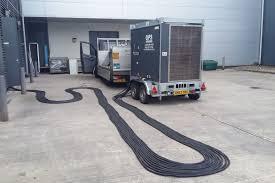Wet stacking of a diesel engine is more common than people think. If the diesel engine is not running at the recommended operating temperature at all times, there are high chances of wet stacking happening in the engine. Most diesel engine generators operate at a suboptimal temperature. And if the engine never reaches the necessary operating temperature that is required to burn off excess fuel and corresponding carbon deposits, wet stacking happens due to a build-up in the exhaust system.
A simple and easy way of recognizing if wet stacking is happening to your diesel engine generator is to see if there is any black ooze around the exhaust pipe or if the engine is continuously throwing black smoke. If the engine is not made to run on the recommended operating temperature, is operated at less than 60 percent of its load, and the air-to-fuel ratio is incorrect, the generator is not used for an extended period of time or too much or too little fuel is used, wet stacking is most likely to happen.
Table of Contents
What is Wet Stacking?
Diesel engine generators have been in use for a long time and they are considered one of the most reliable sources of alternate power. Their efficiency and the ability to perform in extreme weather conditions make them a popular choice of use in different industries including mining, hospitals, military zones, construction sites, commercial industries, transportation, recreational sites, and a lot more. These generators work by burning the fuel (diesel) to induce motion, which is then turned into electric energy. They are mostly used at places where there is no power grid or at remote locations where power fluctuations are quite frequent.
Although quite reliable and efficient in nature, wet stacking is a condition that can make their performance undesirable. It is a condition where the generator oozes out thick, and dark liquid from its exhaust pipe. This happens mainly when the generator is used with less than the desired load. In that case, the generator only generators power that is adequate to run it and defy internal friction. This results in the use of very little fuel and the temperature inside the generator are way below what it is when the engine is operating at full load.
All diesel engines use hot compressed air inside their cylinders in order to vaporize and burn the fuel. A certain degree of temperature is required to completely burn the fuel, and when the temperature is not adequate, the fuel doesn’t burn completely leaving behind elements that get stacked in the exhaust pipe in form of a thick, and black liquid resembling an engine oil. It is this engine oil-like substance that is referred to as wet stacking.
How does Wet Stacking Affect the Generator?
Wet stacking has several adverse effects on diesel engine generators and if the condition is left unnoticed or unchecked, it can have a long-lasting impact on the performance of the engine. Leaving the condition as is can also amount to expensive repairs and replacements.
One of the major issues that diesel engine generators face when wet stacking is left unchecked is that all the deposits of unburned fuel from the combustion chamber build up on the exhaust system and foul injectors. Carbon also accumulates on the exhaust pipe, turbocharger, and exhaust valves. This deposit makes the injector nozzles deliver larger fuel droplets to the combustion cylinders. This in turn increases the amount of fuel accumulation on the exhaust pipe. So, it is a cyclic process that keeps stacking up on its own if left unchecked.
The deposits on the turbocharger reduce the engine’s efficiency, and large amounts of this thick, black and oily material make the exhaust system produce reverse pressure. All of this results in dwindled engine performance and reduced efficiency.
How to Prevent Wet Stacking?
More often than not, preventive measures are the best way to avoid wet stacking. Make sure that your diesel engine runs for at least half an hour, every few days. Operate it at an electric load that generates the recommended temperature, and keep the generator running in a good condition by getting it serviced on a timely basis and letting professionals inspect it regularly.
If wet stacking has already happened, it is advisable to ask our expert at Swift Equipment to inspect it and check the degree of damage done. If the wet stacking is still in the early stage, oue expert can run a load testing procedure to burn off the unburned fuel and rectify the issue, in turn improving the engine performance.
Contact us for any generator related queries
Frequently asked questions regarding wet stacking of diesel engine generators
What are the Effects of Wet Stacking on Diesel Generators?
Wet stacking is a condition where a thick, black, and oily substance gets accumulated in the exhaust pipe of the diesel generator. This can happen if the generator is operated below the optimal electric load. This results in the generation of lower temperatures than the engine requires to the burn the fuel completely. When this happens for extended periods, the amount of accumulation hampers the efficiency of the generator and can also cause long-lasting damage.
How to prevent wet stacking from occurring?
According to the professional generator maintenance expert at Swift Equipment, the best way to avoid wet stacking is to operate the diesel generator at optimal load and maximum temperature so that the fuel is burned completely. Leaving the generator unused for an extended period of time can also result in wet stacking. So, it is advisable to use your generator at least once every few days to keep it running well.
What if wet stacking is left unchecked for a long time?
If wet stacking is left unchecked for extended periods of time, it builds a lot of pressure on the exhaust system, damaging the engine to a large extent. In that case, you might have to go for a major engine overhaul to bring the engine back to its best performance which can prove to be a rather expensive affair. Preventive measures are better than repair work in this case.







Leave A Comment